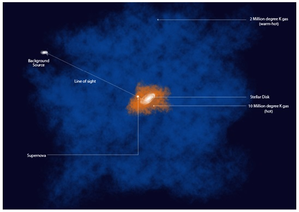New Delhi: An international team of scientists from India and the US have decoded the mysterious source behind fiery hot gas around the Milky Way galaxy.
In the last few years, scientists have discovered gaseous matter pitched to be around 10 million degrees Kelvin hot. Faint X-ray emissions were found in all directions of the Milky Way that bore a strong signature of a super-hot gas.
At the same time, this gas also showed up in the spectra of at least three distant quasars, as an absorbing medium.
Scientists at the Raman Research Institute (RRI), an autonomous institute funded by the Department of Science and Technology (DST), along with their collaborators at IIT-Palakkad and Ohio State University, proposed the mysterious source in two related studies.
They confirmed that the gas responsible for emitting and absorbing the signals detected were not the same. Instead, the X-ray emitting hot gas was caused by a puffed-up region around the stellar disc of the Milky Way.
Since there is a continuous ongoing star formation at various regions across the disk of the Milky Way, the massive stars in these regions explode as supernovae and heat the gas around the disk to high temperatures.
“As such, explosions keep heating up the gas floating around the disc of the Milky Way and they enrich the gaseous matter with elements synthesised within massive stars,” said Mukesh Singh Bisht, doctoral student at RRI.
As this turbulent gas is swept up from the disc and swirls around violently, it either escapes into the surrounding medium or cools and falls back onto the disc.
Further, this absorbing hot gas was also found to be enriched with alpha-elements, said the researchers, in the paper published in the Astrophysical Journal.
“This fiery gas, at least in a few directions, seems to be enriched with large quantities of alpha-elements, such as sulphur, magnesium, neon etc., whose nuclei are nothing but multiples of helium nuclei. This is a vital clue of nuclear reactions occurring within the stellar core. These elements are thrown out of massive stars during supernovae explosions,” Biman Nath, from RRI, said.
IANS
